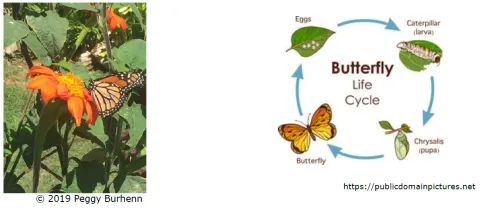By Peggy Burhenn, UC Master Gardener
Butterflies and moths belong to the order of insects called Lepidoptera.

Butterflies Need:
Sun- prefer warm, sunny locations to warm bodies for flight.
Water- need nutrients from edges of puddles or rotting fruit. Fill a bowl with wet sand, rocks or corks.
Wind protection- to prevent cooling and maintain ease of flying.
Nectar plants- rich in sugar, these plants will draw butterflies to your garden. When adult travels from plant-to-plant drinking nectar, they transfer pollen aiding in pollination of plants.
Host plants- Adult butterflies do not care for their young (caterpillars). Instead, the butterfly carefully chooses the host plant for her eggs. Once the eggs hatch, the caterpillars survive by eating the leaves of the host plant.
Nectar Plants for the Adult Butterflies- Some examples:
California Natives- Ceanothus, willows, hollyleaf cherry, coast live oak, lupines, alder, currant, coffeeberry, deerweed, gooseberry, manzanita, buckwheat, yarrow.
Non-natives- black-eyed susan, aster, lantana, coneflower, daisy, lavender, rosemary, sunflower, cosmos, marigolds, verbena, statice, chives, zinnia.
Host Plants (Food Plants) for Caterpillars:
Host plants vary depending on butterfly species:
Monarchs- milkweed; Gulf Fritillary- passion vine; Painted Lady- thistle; Western Tiger Swallowtail-sycamore; Anise Swallowtail- citrus, anise, carrot family; Checkered White and Sara Orangetip- mustards; Acmon Blue- deerweed, buckwheat; Mourning Cloak- willow, cottonwood; California Sister- oaks; Common Buckeye- snapdragon, plantain, monkey flower; Queen- milkweed.
Native host plants- willows, poplars, sycamore, bladder pod, Ceanothus, deerweed, coffeeberry, buckwheat, Indian paintbrush, common sunflower, monkey flower, oaks.
Non-native host plants- passion vine, cassia, sweet fennel, snapdragons.
Host plants are a necessary food source. Caterpillars will strip the leaves and also feed on flowers. Their feeding can make for an unsightly plant, a consideration when choosing the location for host plants.
Tips for Attracting Butterflies and Pollinators:
Use plants of varying height, different flower shapes, annuals and perennials.
Overlapping bloom times and especially early spring and late fall.
Use single flowers; double flowers have less nectar.
Include native plants that are attractive to native bees, including trees.
Plants in the sunflower family are favorites: sunflowers, asters, zinnias, thistles, marigolds.
Plant several plants of one kind in a 3-4 foot block.
Avoid insecticides, herbicides and fungicides in the garden.
References
Heath, Fred. An Introduction to Southern California Butterflies. Mountain Press. 2004
Host Plants for California Butterfly larva. UC ANR. 00 Host Plants for California Butterfly Larva (ucanr.edu)
Plants for Butterflies. UC ANR. 00 Plants for Butterflies (ucanr.edu)
Pollinator-Friendly Native Plant Lists. Xerces Society. https://xerces.org/pollinator-conservation/pollinator-friendly-plant-lists
The Butterfly Book, Little, Brown and Company, Stokes Nature Guide, 1991.
Plants for Butterflies. UC ANR. 00 Plants for Butterflies (ucanr.edu)
Pollinator-Friendly Native Plant Lists. Xerces Society. https://xerces.org/pollinator-conservation/pollinator-friendly-plant-lists
The Butterfly Book, Little, Brown and Company, Stokes Nature Guide, 1991.
Worthington, Leora. Central California’s Migratory Butterflies. UC Master Gardeners of Monterey Bay.
UC Master Gardeners of Monterey Bay - Agriculture and Natural Resources Blogs (ucanr.edu)
